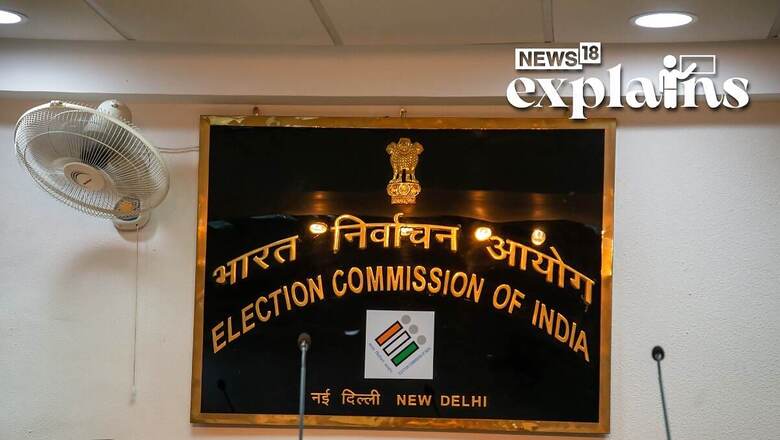
views
The Election Commission of India (ECI) on Tuesday issued a draft proposal for delimitation of the assembly and Lok Sabha seats in Assam with the total number of constituencies retained at 126 and 14 respectively. The poll body has sought suggestions and objections till July 11.
According to the draft, the lowest administrative unit will be village in the rural areas and ward in urban areas. Further, the village and ward have been kept intact and have not been broken anywhere in the state, the poll body added.
What is Delimitation?
According to the ECI, delimitation literally means the “act or process of fixing limits or boundaries of territorial constituencies in a country or a province having a legislative body”.
In India, the job of delimitation is assigned to the Delimitation Commission or a Boundary Commission. Delimitation Commissions have been constituted four times – in 1952 under the Delimitation Commission Act, 1952, in 1963 under Delimitation Commission Act, 1962, in 1973 under Delimitation Act, 1972, and in 2002 under Delimitation Act, 2002.
Under the provisions of the Delimitation Act, 1972, the last delimitation of constituencies in Assam was done on the basis of census figures, 1971, by the then Delimitation Commission in 1976. However, when the exercise was repeated in 2002, Assam was not a part of that.
In the 2002 exercise, Assam, along with Arunachal Pradesh, Manipur, and Nagaland, was left out after a PIL was filed in the Gauhati High Court challenging the use of the 2001 Census for reference.
In February 2020, then President Ram Nath Kovind paved the way for the delimitation exercise in Assam, rescinding the February 8, 2008 order.
What has the EC said in the draft proposal?
In a statement, the EC said all assembly and parliamentary constituencies in the state are being delimited on the basis of the 2001 Census as provided in Article 170 and Article 82 of the Constitution. While the limits of the constituencies have changed, the total number of the seats have remained unchanged in the state both at the assembly as well as at the Lok Sabha level.
“The number of seats in the Legislative Assembly and the House of People in the state of Assam has been retained as 126 and 14 respectively. Articles 170 and 82 laid down that the number of seats in the Legislative Assembly of each state and the allocation of seats in the House of the people to the states shall not be altered until the relevant figures for the first census taken after the year 2026 have been published,” the poll body said.
What will change now?
After implementation of this draft proposal, the state will have new assembly and parliamentary constituencies. However, not all will see major changes.
Among the districts that have seen major changes is Bodoland where the assemblies have increased from 16 to 19. One assembly seat has also increased in the West Karbi Anglong district.
In terms of Parliamentary seats, two Lok Sabha seats were given to the Barak Valley districts (Cachar, Hailakandi and Karimganj). Also, the Tezpur Lok Sabha seats will now be called Sonitpur. Among the new names for the Lok Sabha seats included Kaziranga, Diphu and Darrang.
The assembly seats reserved for Scheduled Castes have increased from eight to nine while those for the Scheduled Tribes have jumped to 19 from 16 earlier.
“The draft proposal has been prepared based on administrative units i.e., development block, panchayats and village in rural areas and municipal boards, wards in urban areas,” they added.
How EC handled uneven population growth while dividing seats?
During the discussions, it was highlighted that there was an uneven population growth pattern in Assam. While some districts have undergone more population growth since last delimitation, others have witnessed less population growth.
It is seen that the population density in the districts of the state varies from 38 persons per square km in Dima Hasao district to 1,096 persons per square km in Kamrup (Metropolitan) district.
Taking all these factors into account, the EC has categorised all 31 districts in three broad categories A, B and C giving a margin of (+/-) 10% of average population per Assembly constituency.
“The average population density of the state is 338 persons per sq.km. A population density range of 304 (subtracting 10% from the average population density) to 372 (adding 10% to the average population density) has been established and on this basis, three categories have been made,” the ECI said.
Districts having population density less than 304 persons per sq. km were grouped as A while those with population density between 304 to 372 persons per sq. km were called B. Districts where population density was more than 372 persons per sq. km. were termed C.
Assembly seats to the districts have been allocated on the basis of category of the district. The number of seats for a particular category district has been arrived at by dividing the total population of the district by the average assembly constituency population of category A, B, C as applicable to the district.
“On this basis, 122 assembly seats are allotted to the districts. Four assembly seats were left out from allocation while adopting this criterion. All the districts having a fraction in the range of 0.25-0.49 were sorted out and of such 10 districts, four districts having the largest geographical area were allocated one seat each,” the ECI said, adding that these districts were Cachar, Kokrajhar, West Karbi Anglong and Udalguri.
ECI team to revisit Assam in July
The commission will visit Assam again in July 2023 for a public hearing on the draft proposal. Earlier, the team had visited the state in March and representations were received from 11 political parties and 71 organisations.
The EC has devised the guidelines and methodology keeping in mind the constitutional and legal provisions and the suggestions received.
“Efforts have been made to keep all constituencies, as far as practicable, as geographically compact areas, and in delimiting them, regard has been had to the physical features, density of population, existing boundaries of administrative units, facilities of communication and public convenience,” the poll body added.

















Comments
0 comment